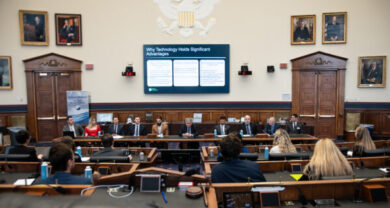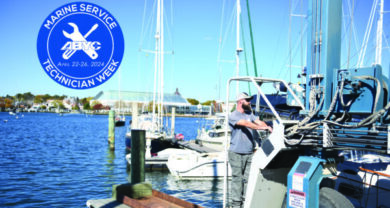Multi-agency, association agreement seeks to bolster boating, fishing
The U.S. Fish and Wildlife Service (USFWS), Bureau of Land Management (BLM), and the U.S. Forest Service (USFS) have announced a new memorandum of understanding (MOU) with the Association of Fish & Wildlife Agencies (AFWA), the American Sportfishing Association (ASA), the National Marine Manufacturers Association (NMMA) and the Recreational Boating & Fishing Foundation (RBFF).
The unprecedented MOU, signed just after U.S. Secretary of the Interior Ryan Zinke declared October will officially be recognized as National Hunting and Fishing Month, was created to develop and expand cooperation among the participating parties for planning and implementing mutually-beneficial projects and activities to promote recreational fishing and boating conducted on public lands and waterways.
“Anglers and recreational boaters help bolster many local economies in the pursuit of these American pastimes,” Zinke said. “We want to make sure to encourage more people to cast out their lines and get their boats out on the water. Partnerships like this are vital as we work to increase access to public lands and waters and pass on these traditions to future generations.”
Recreational fishing and boating are fundamental aspects of America’s outdoor recreation and conservation heritage, and are great ways for people to connect with family and friends, said Greg Sheehan, Principal Deputy Director of the U.S. Fish and Wildlife Service.
“We look forward to working with all of our partners to continue to increase the number of anglers as well as opportunities for the public to get out and enjoy America’s healthy aquatic resources,” Sheehan said. “As a lifelong angler, I understand the importance of building strong partner relationships to further the opportunities for fishing by all.”
The agreement is a natural fit for the Bureau of Land Management, said acting BLM Director Michael D. Nedd.
“We manage more than 132,000 miles of fishable rivers and three million acres of lakes and reservoirs–many of which offer truly world-class recreational opportunities,” Nedd said.
The Forest Service has a long history of working with partners to promote fishing and boating on public lands, said Deputy Chief of National Forest System, Leslie Weldon.
“With over 10 million acres of lakes and reservoirs and 220,000 miles of fishable rivers and streams, the National Forests and Grasslands are the perfect place to connect with the outdoors. This MOU will help us work as partners to provide excellent access and facilities for people to enjoy,” Weldon said.
The objective of the MOU is to promote angler recruitment, retention and reactivation (R3) activities with the goal of increasing the current 47 million recreational fishing participants in the U.S. age 6 to 60 million at the end of 60 months, or by 2021.
Dubbed ‘60 in 60’ by RBFF, the initiative was launched in April 2016. Some efforts that may take place because of the MOU include increased volunteerism on public lands, improved quality of aquatic and riparian resources, improved recreational fishing experiences, and increased educational programs for recreational fishing and fisheries.
“Outdoor recreation is one of this nation’s largest economic engines. This agreement shows a great commitment to connecting millions of Americans to the outdoors by working with the fishing and boating industry and the larger conservation community,” said Ron Regan, executive director of the Association of Fish & Wildlife Agencies. “State fish and wildlife agencies are eager to work with our federal and NGO partners to increase overall fishing and boating participation and recognize the essential role boaters and anglers play in supporting and funding conservation and outdoor recreation nationwide.”
Fisheries conservation and management in the U.S. is largely paid for by anglers and boaters, said ASA President and CEO Mike Nussman. “Through the Sport Fish Restoration and Boating Trust Fund, which is primarily funded by excise taxes attributable to fishing tackle and motorboat fuel, approximately $600 million is distributed annually to all 50 states for fishery projects, boating access and aquatic education. Increasing the number of people fishing and boating is essential for healthy fish and clean waters.”
The MOU provides a tremendous opportunity to work together with our partners in the outdoors and the Department of the Interior to ensure sufficient access and conservation of our nation’s public waterways, said NMMA President, Thom Dammrich. “Waterway access and conservation are critical to recreational boating—an industry made up of nearly 650,000 people who help deliver an estimated $121 billion in annual economic impact in the U.S. each year.”
The MOU will further advance what was a strong first year for ’60 in 60’ in which fishing participation among Americans age 6 and older increased by 1.5 million according to the 2017 Special Report on Fishing, along with increases in key growth segments for the industry including youth and Hispanics.
The recently-released USFWS 2016 National Fishing, Hunting, and Wildlife-Associated Recreation national survey also revealed an increase in fishing participation – up 8.2 percent over the last five years among Americans over the age of 16.
In addition, the survey revealed fishing participation is up nearly 20 percent over the last 10 years and reached its highest mark since 1991.
In a new Recreational Boating Participation Study from NMMA, Discover Boating, and RBFF, 142 million Americans went boating in 2016. Of the 142 million individuals, 17 million were first-time participants, and half these first-time participants were children under the age of 18.
Fishing remains the number one activity done from a boat.
“Fishing and boating participation numbers look good right now, but with all of the demographic changes taking place in our country, and the rapidly-growing use of technology, we’ve all got to up our game,” said RBFF president and CEO Frank Peterson. “This partnership is a fantastic start to a cooperative effort on the national, regional and local level to ensure fishing and boating participation thrive for years to come, supporting critical state agency wildlife management efforts.”




